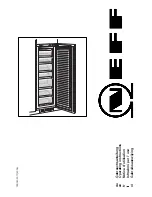
About climate categories
• Always ensure the prescribed ambient
temperature is maintained (see “Intended
use” on page EN-4).
Climate category means that the appliance is
intended for operation at the specified ambi-
ent temperature (see table “climate catego-
ries”). If the room temperature drops signif-
icantly below this, the unit will not switch on
as often. This indicates that an unwelcome
increase in temperature may occur.
Setting up and aligning the
appliance
NOTICE
Risk of damage!
Insuffi cient air circulation may lead to
overheating and cause damage to the
appliance.
■
The entire space above the appliance
must remain clear.
■
The appliance should not stand di-
rectly against the wall (leave a mini-
mum clearance of 5 cm).
1. Place the appliance on as flat and as firm
a base as possible.
2. Check the position with a spirit level.
(13)
(4)
3. Level out any unevenness on the ground
using the four screw feet (4) and (13).
• Close the door.
• Tilt the appliance backwards slightly
and screw in/unscrew the screw feet (4)
or (13).
• Stand the appliance back up again and
check the alignment with a spirit level.
• Repeat the process until the appliance
is standing up vertically. The appliance
should not move when opening the door.
“Climate categories” table
Zone description
Code Definition
Extended temperate zone
SN
This refrigerator is designed for use at ambient
temperatures of +10 °C to +32 °C.
Temperate zone
N
This refrigerator is designed for use at ambient
temperatures of +16 °C to +32 °C.
Subtropical zone
ST
This refrigerator is designed for use at ambient
temperatures of +16 °C to +38 °C.
Tropical zone
T
This refrigerator is designed for use at ambient
temperatures of +16 °C to +43 °C.
Start-up
Page EN-23










































